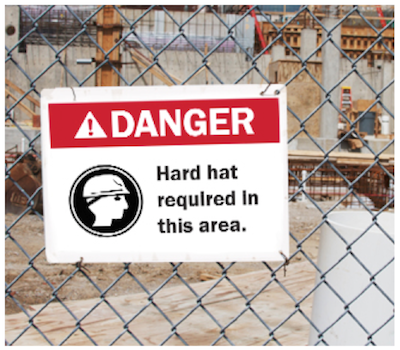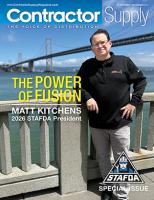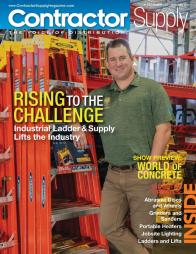Exclusive: Ways to improve construction site safety
Graphic Products shares tips for preventing accidents on the job site.
By Kelsey Rzepecki
 The term “time is money” is quite literal in the construction industry. The constant pressure project managers and crews face to meet deadlines and stay within budget often causes safety to fall to the wayside.
The term “time is money” is quite literal in the construction industry. The constant pressure project managers and crews face to meet deadlines and stay within budget often causes safety to fall to the wayside.
In 2016, out of 4,693 worker fatalities in private industry, one in five were in construction. Implementing each of these strategies can help improve health and safety in construction on any job site:
Set Safety Expectations
OSHA’s Safety and Health Regulations for Construction: OSHA 29 CFR 1926 serves as a baseline for safety requirements. Safety management in construction must reinforce these regulations and go beyond by continuously leading by example and making safety a priority before work begins. By setting clear expectations for safety from the beginning, managers can set the tone to ensure each worker understands their personal responsibility for safety. This will help everyone work together toward the common goal of preventing injuries.
As a safety manager, it’s important to “walk the talk” when it comes to workplace safety and health. “The example you set, and the way you talk to workers about safety, has a huge impact on the company’s safety and health program, safety culture, and ability to reduce injury and illness,” according to OSHA. When workers are able to recognize the value management has for their well-being, it helps build trust.
Some workers may never interact with senior management. It’s found that these employees are more likely to value and internalize safety messages when they are occasionally delivered by higher-level management rather than passed down in the chain of command. Make it clear that it is everyone’s responsibility to follow rules, procedures, and best practices to prevent accidents on the job site. Incorporate safety language into policies and procedures so it becomes ingrained as a natural part of a worker’s daily routine.
An informal safety talk at the start of each work day can make safety managers’ jobs easier by improving worker understanding of safety expectations, preventing wasted time on inconsistencies, and minimizing chances of error. Toolbox talks continue to be the most effective means of communicating safety to workers. It sparks valuable discussion on general safety and information about safer tools, equipment, materials, and processes.
Utilize OSHA’s website for a variety of topics from emergency planning, tool and equipment safety, ladder safety, personal protective equipment, and more to help create or obtain a presentation. Always make sure the content is relevant to your specific work site and feature engaging elements like visuals and anecdotes that workers can connect with.
Promote a Nonthreatening Environment
The authors of Crucial Conversations conducted a survey of 1,500 workers in 22 organizations and found 93% of employees say their workgroup is currently at risk from a safety issue that is not being discussed. In addition, almost half knew of an injury that occurred because someone didn’t speak up. Trust and quality of relationships heavily influence the safety and overall productivity of workers.
Always encourage employees to speak up when they see something going wrong; this can significantly help to avoid incidents, injuries, and fatalities. To increase chances of participation, ensure workers feel comfortable to ask questions and raise safety concerns without fear of retaliation or bullying. This will make it easier and quicker to address issues head on to prevent them down the road.
OSHA finds that managers often avoid giving feedback to prevent confrontations. If improvements to a worker’s performance can be made, approach them in a constructive, positive way. Make sure to avoid judgmental statements and criticisms and focus on the behavior itself, not the person and their values or personality.
Plan Ahead
Ensure all prework activities, such as approvals, are completed before work begins. A thoughtful planning process can help the work day start on a more efficient and safe foot. Implement zoning to block off areas where certain tasks will take place, install nets and catch platforms, and apply any other safety measures.
Stage and stock each work area with the necessary tools, PPE, and equipment before the workday begins. This will make it easier and safer for workers to access what they need. Make sure to supply the right tools for the right tasks, and double check that workers understand how to properly operate the equipment they’ll be using. Eliminate hazardous distractions and obstructions by reinforcing consistent housekeeping practices on the job site.
Take Advantage of Technologies
Provide new opportunities to address safety challenges and experience immediate cost savings. Technology can be worth the investment to help bridge time and distance constraints, improving efficiency and safety in the long term.
The growth of digitization in construction now makes it possible to make real-time decisions remotely. Unmanned aerial vehicles (UAVs), known as drones, are already in use in the industry and provide a convenient way to conduct site inspections, observations, and safety audits. Managers can use smartphones, tablets, and project management software to share project data instantaneously from remote work sites and to workers and other onsite supervisors using a cell phone or tablet.
Allowing everyone to have immediate access to the same information eliminates costs of equipment that must be updated and maintained, and it keeps everyone consistently on the same page.
A recent report by Dodge Data & Analytics found that 82% of contractors who use wearable technology see instant site-safety improvements. Wearable devices like smart watches, glasses, and clothing allow managers to have better visibility of the work site and workers. These devices have the ability to alert managers to activities going on in the field and even improve response time when injuries occur, like the ability to detect when an employee slips, trips, and falls, triggering an automatic alert to designated site personnel, including medics.
These devices also keep track of locations of workers and procedures on the job site. Trigger alarms exist to streamline evacuation procedures in the event of an emergency. These capabilities offer immediate safety benefits. There are also a number of free iOS applications that exist to promote hazard prevention efforts.
Easy to Implement Safety Solutions
One of the most important parts of safety on a construction site is clear and effective communication at all times. An easy way employers can communicate with workers in different areas on a job site is through safety signs and labels. Comply with OSHA and ANSI standards and reinforce safety anywhere on the work site with easy to install premade construction labels and signs.
For on-demand custom, site-specific procedures and instructions, DuraLabel printers and supplies are a reliable safety communication solution. All supplies are built to last in the harsh conditions that exist in the construction industry.
Thoughtfully implementing each of these strategies will help to prevent downtime, chances of injury, and improve overall safety on a construction site. CS
Kelsey Rzepecki writes for Graphic Products, makers of the DuraLabel line of industrial label and sign printers. For more information about customized visual communication, visit www.GraphicProducts.com or call 800.788.5572.
















